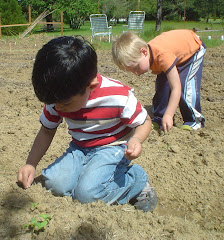By Llyn Peabody
If
you grow your own lettuce, as the weather warms, it's not uncommon to
have some of it "bolt" (try to go to seed). Saving lettuce seed is
fairly easy and a good entry-point for those new to the process. Here is
a re-publishing of a post we wrote back in 2011 but the information is
just as relevant today. Happy seed-saving :-).
Saving your own seed is an important aspect
of developing local food self-reliance. Relying on commercial seed
farmers may become increasingly unreliable as climate change disrupts
weather patterns and seed crops falter. Growing your own seed slowly
modifies your plants to be uniquely suited to your micro-climate and
growing conditions. Networking with other seed-savers in your area
builds a sense of community.
LINK: Locally Sustainable Gardening in the Face of Supply-Chain Shortages
 |
| Lettuce flowers - close-up. |
|
|
Seed-saving
can seem intimidating at first. I know I felt that way. Many
vegetables will cross with their neighbors yielding inconsistent
results. There are many questions that must be answered before moving
forward. For this reason I definitely recommend Suzanne Ashworth's "Seed
to Seed". It is a comprehensive manual that covers all aspects of
seed-saving. I am also grateful to my husband, Chris, for all he has
taught me from his 40+ years of gardening. He's helped me translate the
book knowledge into experiential learning. Saving seed appeals to the
outlaw in me, I guess. Like treating illness with herbs I grew myself,
there is something empowering about developing skills usually left to
"the experts". As it turns out, it's not really that difficult at all.
 |
| "Red Sails" lettuce - blooming. |
|
|
|
Saving Lettuce Seed:
Like most things in gardening, a bit of forethought goes a long way.
Ashworth recommends 12' - 25' separation between types of lettuce to
prevent cross-pollination (the farther the better). Plan your plantings
(and harvesting) to leave sufficient distance between the flowering
plants.
Though you may have enough time to bring a Fall crop of
lettuce to seed, we usually do our seed-saving with the lettuce we
plant in the Spring.  |
Note:
Be sure there is no wild lettuce that is forming seed near the
varieties of domesticated lettuce you are saving seed from as it can
cross. The plants that grow from these crossed seeds tend to be more
bitter and course. There are several varieties of wild lettuce; this one
is named Lactuca Serriola LINK.
|
 |
| Lettuce bolting - Black-Seeded Simpson |
|
|
|
Lettuce
is an "annual" crop. This means that the plants will produce seed in
one season (without over-wintering). As the weather gets hotter and
drier you will notice on romaine or "leaf" lettuce a definite
lengthening of the plant. ("Leaf" types form a loose rosette of leaves
but not a tight "head). When it lengthens, it is starting to "bolt".
Lettuce that is bolting gets noticeably more bitter (probably nature's
way of protecting the plant in this important phase of its
reproduction). On "head" lettuce (such as Iceberg), Ashworth says it can
be helpful to slit the head, forming a cross-cut with a sharp knife,
making it easier for the flower-stalk to emerge. She says some gardeners
strike the head of the lettuce with the palm of their hand thus
breaking the leaves away from the stalk. Without some effort to free the
flower-stalk, head-rot from heat and humidity may kill the plant
before it can go to seed. So far we have saved seed mainly from "leaf"
lettuce. This summer we will experiment with our red and green "head"
lettuces to see what works best for us and report back.
 |
| Lettuce marked for seed with bamboo. |
|
|
|
As we are gardening with a group of
people, we have found it essential to clearly mark the plants that we
are saving for seed, so they are not harvested by accident. We have
made small tipi's with bamboo sticks, tied a red ribbon around the
plant or put a small sign on a stake and driven it in nearby. Even a
plant that is obviously past an edible stage for harvest is not safe as
a well-meaning fellow-gardener may assume the responsible thing to do
is weed out your seedy lettuce plant and toss it on the compost pile!
 |
| Staked lettuce - the flowers get heavy. |
|
|
|
As the flower stalk grows it will produce a
big head of flowers. You may need to tie it to a stake so it doesn't
fall over. Seed production occurs 12 - 24 days after flowering.
Ashworth says you can harvest seeds daily by shaking the stalk over a
large paper sack. The ripe seeds will fall into the bag. The method we
have used is to wait until the majority of seeds are ripe and to cut
off the whole flower head and place that in a paper sack. Leave the
sack open in a warm, dry place (like the top shelf your tool shed)
until the flowers are thoroughly dry. Be sure to label the bag with the
name of the lettuce variety. If mice are a problem and you have the
space, try hanging the open bag from rafters.
To
winnow the seeds, roll the flowers between your fingers and the palms
of your hands to free them . Lettuce seed is challenging to separate
because the seeds are not much heavier than the chaff. Patiently drop
small amounts of the seed/chaff over a tray, from a height of a foot or
two while blowing gently. The seed should drop and the fluff blow away.
Some people run the seed through screens but we have not tried this
method. Commercially available seed-sifting screens are another option.
They have different sized holes.
 |
| Put ripened lettuce flowers into a paper bag to finish drying. |
|
|
|
Lettuce seed will remain viable for 2-3 years if kept in a cool, dark place, in an air-tight container.













































No comments:
Post a Comment